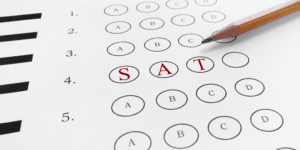“Remote” has become the adjective of choice in the wake of the ongoing COVID-19 pandemic, and grad tests certainly have not been spared. For the Law School Admissions Council (LSAC), this has led to the advent of the LSAT-Flex, a somewhat modified, remotely proctored version of the traditional LSAT.
Traditionally, the LSAT was administered in LSAC-approved test centers as a pencil-and-paper exam. In 2019, the LSAT switched to a digital format, with the test being administered on tablets but still in person. Then, due to COVID-19 restrictions across the globe, the LSAC canceled the April 2020 in-person LSAT and rolled out the LSAT-Flex, a shortened version of the test administered remotely, shortly thereafter.
Finally, in mid-2021, the LSAC announced that the LSAT-Flex would drop the “Flex” designation and become the default version of the test until at least June 2022, pending developments with the COVID-19 pandemic. For the purposes of this article, however, we’ll generally continue to refer to the remote, shortened LSAT as the LSAT-Flex in order to differentiate it from the “standard” version of the test.
LSAT-Flex Format: What is the LSAT-Flex?
The LSAT-Flex is the remotely-administered version of the LSAT, meaning you take it from the comfort and safety of your own home. However, despite being a remote exam, the LSAT-Flex is still proctored, similar to the in-person digital LSAT. Through ProctorU, a remote-proctoring organization, you will have a live proctor and AI monitoring you for any prohibited activity.
What to expect: The format of the LSAT-Flex
Traditionally, the LSAT consists of two Logical Reasoning sections, one Analytical Reasoning section (a.k.a. logic games), and one Reading Comprehension section, with a non-scored experimental section from any of the above categories and a non-scored argumentative writing task taken at a separate time from the rest of the test. The LSAT-Flex’s unique format does away with one of the two Logical Reasoning sections, shortening the test noticeably.
Despite Logical Reasoning historically taking up 50% of the LSAT’s weight, the LSAC has announced that the lone Logical Reasoning section on the LSAT-Flex will have the same weight as Analytical Reasoning and Reading Comprehension. It will also have the same difficulty as on previous tests. Thus, preparation for the LSAT-Flex should give equal weight to the sections. There is no longer notable benefit to spending additional time on the Logical Reasoning section unless it is already a weaker section for a given test-taker.
Scratch Paper
Since you will be taking your LSAT-Flex remotely, there are additional security measures in place. You are allowed a limited amount of scratch paper—five sheets, to be exact—which you must destroy in front of your proctor at the end of your test. The LSAC has not given clear guidance on size limits, so it is best to have plain 8.5×11 paper as a standby.
LSAT-Flex Format: Scoring the LSAT-Flex
Your LSAT-Flex score will be on the same scale as the traditional LSAT: 120-180. Your score report notates that a given administration was taken remotely, but this is rather moot, since no administration has offered both in-person and remote testing.
LSAT-Flex Score Conversion
While the actual LSAT-Flex will be scored for you, you may want to use an LSAT-Flex score converter to evaluate how you can expect to do on the Flex, based on a score from a previously taken, four-section PrepTest. Fortunately, it’s fairly easy to do on your own, this. Warning—there is math. Since the traditional LSAT has 33% more questions than the LSAT-Flex, all you need to do is take your raw scores from Reading Comprehension, Analytical Reasoning, and the lower scoring Logical Reasoning, and multiply by 1.33. This will represent your raw score for an LSAT-Flex. Then convert your new raw score to a scaled score using the scale for that particular PrepTest. Nice and easy!
LSAT-Flex Practice Tests
There are a few options for taking your practice tests, depending on your preferences. Since the LSAC has as of writing only provided two LSAT-Flex practice tests online, you may need to do some extra work to get in enough practice tests. The first, and easiest, method is to simply take your PrepTests as usual, select three sections instead of four, and use the above mentioned LSAT-Flex score converter to get a ‘Flex’ score. The other option is to use PowerScore’s LSAT-Flex and Analytics tool, a subscription-based service that pre-converts an LSAT PrepTest into an LSAT-Flex practice test. This allows for a more accurate experience and plenty of useful analytics, but does incur an additional cost.
LSAT-Flex Format: System requirements
Since this is a remote exam that uses AI as part of your proctoring, you will need to meet certain system requirements. Most importantly, tablets and ChromeBooks are not supported; you will need a laptop or desktop computer running either Windows or Mac. Additionally, you need a working webcam and microphone. If you do not have access to the necessary equipment or space, reach out to the LSAC by the assistance request deadline.
Get started with LSAT-Flex Prep today
At the end of the day, the format of the LSAT-Flex is a modification of the already existent digital LSAT. Knowing what to expect is the first step in developing your LSAT confidence. Using the right LSAT test prep for you is the next step. To learn more about test prep with Inspirica Pros, connect with our team of online LSAT tutors today!




